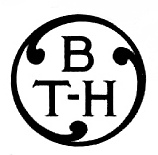
The British Thomson-Houston company Limited was yet another of those classic British electrical manufacturers with a long and labyrinthine history. It is perhaps most famous for having built the world's first prototype jet engine for Sir Frank Whittle in 1937. The company was created in 1896 with funding from GE in the USA, and thus was in some ways similar in its origins to Standard Telephones and Cables Ltd.
However, in 1926 BTH became one of several (potentially competing) UK electrical companies to fall under the umbrella of a holding company called Associated Electrical Industries Ltd (AEI), which went on to buy further UK industrials. This unusual situation persisted for some decades, but in 1958 the BTH name was replaced by AEI on their products. The unusual nature of AEI and the general decline in heavy industrials led it into financial difficulties and in 1967, AEI was absorbed into the still-expanding GEC and disappeared as a brand.

Transistors and other semiconductors were a relatively minor part of BTH/AEI's product line, however the company was certainly a middle-rank manufacturer by UK standards. However, information about this aspect of their industrial history is scarce. The change of name from BTH to AEI occurred just after the company started manufacturing germanium transistors, and so both sets of initials can be found on early devices. (They always painted their transistors, usually in a bright colour, but never printed their logo on them, although many of their diodes bore it). The company's main industrial plant was based in Rugby, but their semiconductors, apart from perhaps the oldest diodes, were made at the AEI plant in Lincoln. If you know anything about this, or have other information about BTH/AEI's semiconductor history, please
I have a few BTH data sheets from 1958, and data booklets on AEI semiconductor devices dated 1960, 1961 and 1963.
I do not possess all the semiconductors below, in fact I am seeking many of them. It is noted in the text where I am seeking examples of any particular type: if you have some for sale or exchange, please
Conversely, I am happy to help anyone looking for information on these devices. I have an extensive collection of original data sheets and books, and can provide some information on most BTH/AEI types.

I have an old BTH 'Crystal Rectifiers' leaflet, that I believe is dated July 1948, that states that in 1941 BTH produced what it called a 'Crystal Valve' for use in centimetre-wave radar and radio equipments. No more details are given but the leaflet also states that types CS1, CS4 and CS5 are 'no longer available', having been replaced by the types in the leaflet. Naturally, I would be interested to obtain these obsolete types or a contemporary data sheet for them, or even just see some, so if you know of any, please
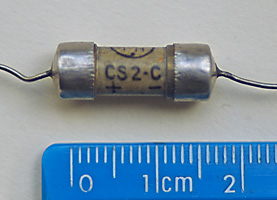
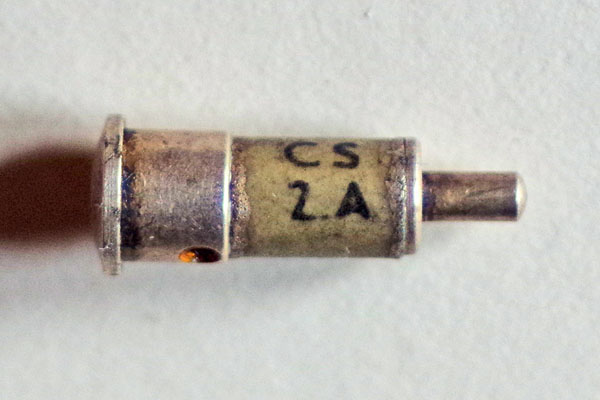
The leaflet describes types CS2, CS3, CS6 and CS7. Three shapes are used:
- Form A is decribed as a 'single plug assembly' and is the familiar microwave diode plug shape.
- Form B is described as a 'fully screened assembly' and is a co-axial 'cartridge' shape.
- Form C is a wire-ended assembly.
However, each type did not come in all three forms. The ones listed are CS2-A, CS2-C, CS3-A, CS3-B, CS6-A, CS6-C, CS7-A and CS7-C. My images show CS2-A and CS2-C, the only ones of the set that I have found, the latter of which is intended for 'special applications'. The others have various functions: frequency converter, rectifier, detector. I would be interested to obtain examples of any of the others, so if you can provide any, please
The CS series of microwave diodes went on until CS41 at least.
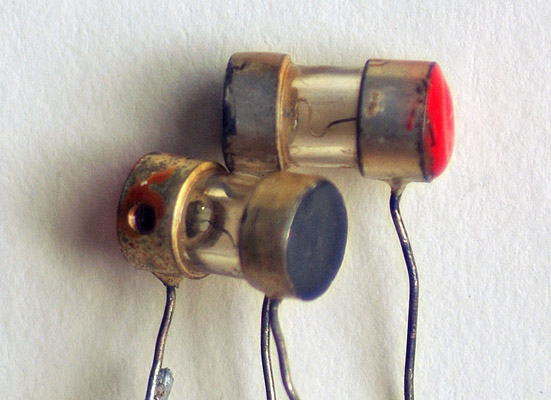
I have a second BTH leaflet, dated September 1949, called 'Germanium Crystal Rectifier Type CG1, Form C'. This would appear to document BTH's first germanium diode. However, they have changed Form C from axial wires and a ceramic body to wires at right angles to a glass body. The leaflet states that one end cap is painted red and the other black. My image shows two diodes like this.
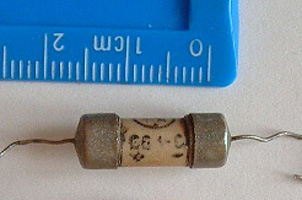
However, I have several CG1-C and more are in the older ceramic axial body than the glass one! I have no original data for this shape, so if you can provide any, please
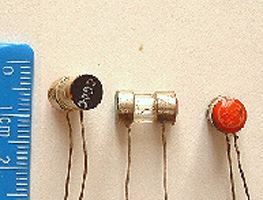
BTH went on to make several such CG Form C types. Practical Wireless December 1952 explains that they are distinguished by colour-coding : the cathode is still red, and may or may not have the BTH logo overprinted on it in white (I think it rubs off quite easily) while the anode end is coloured according to the type:
However this would seem to cause confusion between CG6-C and the original CG1-C. Furthermore, my image shows one with a black end overprinted CG4-C which is inconsistent with the documentation.
I am interested in obtaining more examples of this shape, so if you can provide any, please
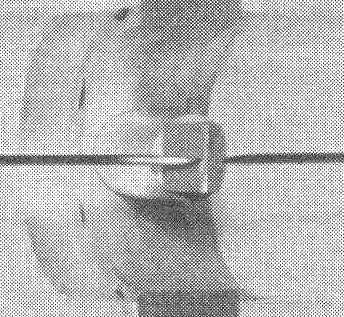
The first reference to a transistor made by BTH is rather mysterious. In his 1954 book, 'Crystal rectifiers and Transistors', the author E.Molloy and consulting editor M.G. Say show a cutaway coaxial transistor with the point contacts at both sides just below the apex of a triangular-prism crystal. This is a rather unusual form of the point-contact transistor, one that was never commercialised, but did explain some physics of the operation of point-contacts. Molloy states that his image (which looks more like a model than a real device) shows an experimental transistor which B.T.H. 'originated in 1948'. My image is an enlarged scan of the centre of the device: the printing dots of the book can be clearly seen. Molloy goes on to state that the germanium die is about 1/16 of an inch square. The next reference that I have found to BTH transistors is to junction types in Bettridge's book published in 1954. What happened in the intervening six years?
Two correspondents have come forward to shed light on BTH's important role in the early semiconductor industry. Harry Metcalfe reveals an exciting connection between BTH and Bell Laboratories' work on germanium.
A BTH apprentice at the time, Richard Groom, has provided me with a fascinating account of what he believes happened.
These two accounts seem to agree that BTH did not see any future in the point-contact transistor, and simply stopped work on transistors in 1950. Later, when others had proved the viability of the junction transistor, they resumed work on those. In view of this, the further statement in Molloy's book that 'some thousands' of this co-axial type were made seems most improbable. However, I would be extremely interested in any surviving specimens, so if you know of any, please I am also very keen to tie up the the two histories recounted by Metcalfe and Groom, so if you can shed any light on them, do

The next reference to the earliest BTH transistors is also mysterious. In the 1954 book 'Transistors and Crystal Diodes', B.R.Bettridge refers to three BTH transistors, JT1A to JT3A. These are also listed in the 1959 book 'British Transistor Manual' by E.N.Bradley, in the section on obsolete types. I have no further information on these devices and I am very keen to obtain examples of them. If you know anything at all about these transistors, or BTH's early semiconductor research, please
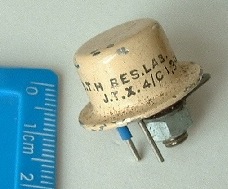
I do have two BTH transistor types in the JT series, although I have no documentation for either. BTH did not use this prefix for their commercial devices, switching instead to the GT prefix. This image shows a power transistor marked 'BTH RES LAB' and 'J.T.X.4/C'. This is clearly a research device and the number 4 would seem to imply that it follows on from JT3, although the extra X almost certainly means 'experimental', and the suffix is C rather than A.
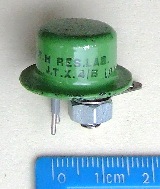
This image shows an almost identical power transistor, except that it is marked J.T.X.4/B and it is painted green. For this device, the suffix cannot refer to the shape as it does for other BTH devices.
I have a further unmarked example in the same shape, but painted blue.
These are the only BTH power types known to me: they made no commercial power transistors. Again, if you can explain any of this, please
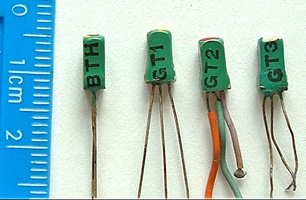
The low-power AF/IF types GT1 to GT3 are first described in the Wireless World book 'Radio Valve Data 5th edition' for 1957, and the evidence suggests that these were BTH's first commercial types. Perhaps they are modified versions of the JT1A to JT3A. As with all early germanium junction types, they have a rather low collector voltage and power dissipation, 9 volts and 125 milliwatts respectively. However, they are unusual in having a relatively high cut-off frequency of 800 kHz to 1MHz, thus allowing them to be characterised as AF/IF and low-frequency switching types. The three types are distinguished by increasing gain and cut-off frequency from GT1 to GT3.
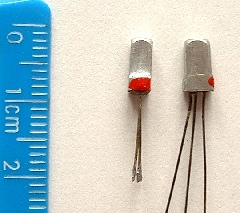
Interestingly, BTH transistors, presumably out-of-spec examples, seem to have been made available cheaply to the home construction market. These 'red spot' devices are unmarked and unpainted and were normally used at audio frequencies in amateur projects. They are clearly BTH types, possibly rejected GT1 to GT3.
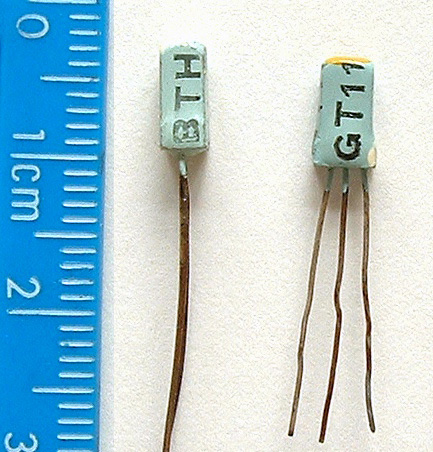
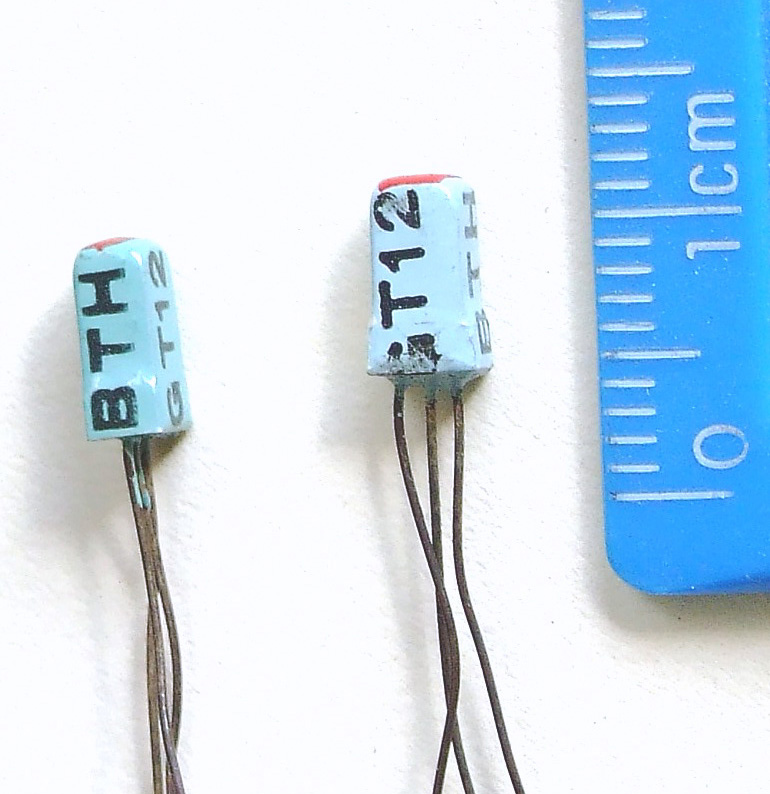
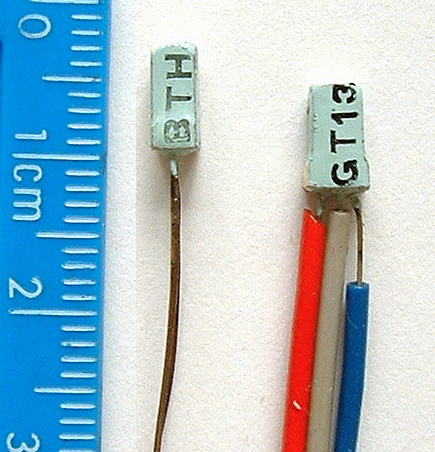
Also found in 'Radio Valve Data 5th edition' are the trio GT11 to GT13 which employ the same small outline as GT1 to GT3, and have the same voltage and power limits, but have significantly higher cut-off frequencies of 3 MHz, 5 MHz and 7 MHz respectively. BTH characterised them as suitable for 'intermediate and high speed switching applications. Also used as a self-oscillating frequency changer and i.f. amplifier'.
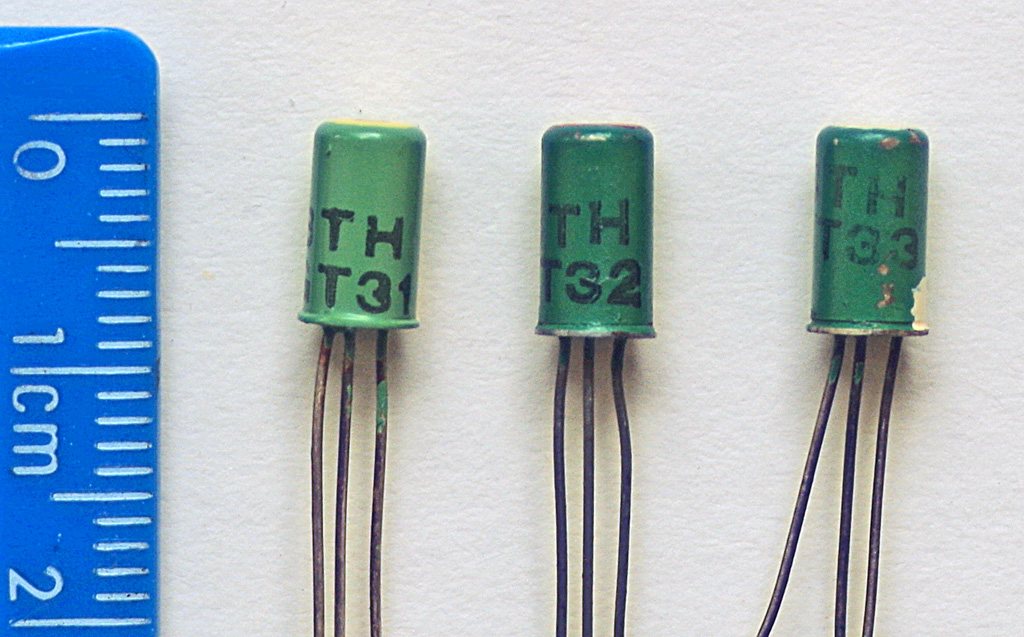
Information about these three types GT31 to GT33 is quite difficult to come by, as they do not appear in most transistor data books from the late 1950s. However, they are described in the 1960 'British Semiconductor Guide' as a trio of low-power AF and general-purpose devices, with increasing gain from GT31 to GT33. Interestingly, the booklet shows them as made by AEI, but I have some that are still branded BTH. The fact that they are green, as are GT1 to GT3, suggests that this colour means 'audio frequency', while light blue means 'intermediate frequency'.
I believe that these are the lowest-numbered GT-series types that can be found branded AEI as well as BTH.
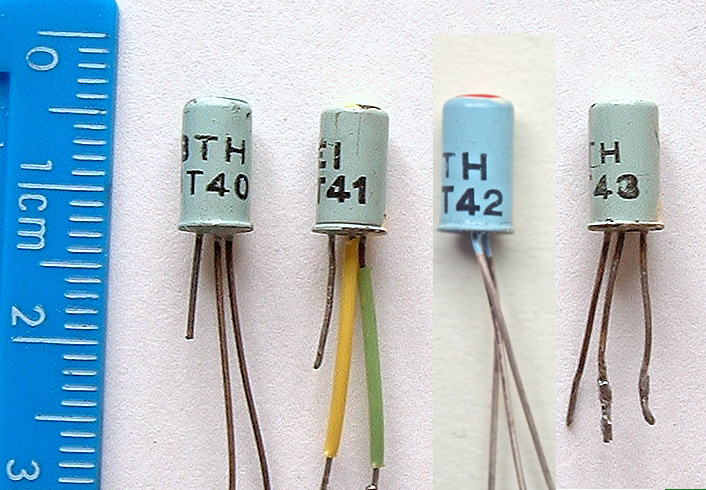
The four types GT40 to GT43, although apparently a series ordered by cut-off frequency, and hence gain, were in fact released as the trio GT41 to GT43 in about 1960, with the lowest-performing type GT40 being added in about 1961. They are IF amplification and high speed switching types, and BTH/AEI seem to have specialised in this higher-frequency regime, used mainly in signalling and computing applications, rather than the technologically easier audio frequency market. They have quite a low maximum collector voltage of 9 volts DC, 15 volts peak.
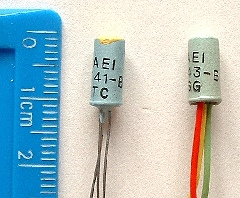
The GT4x transistors also come in a slightly larger encapsulation as shown here, identifiable by a -B suffix on the type number. Only AEI branded examples seem to have this form, which presumably allowed a higher power dissipation. However, no reference to this is made in any of the AEI data booklets that I possess.
I am seeking examples of GT40-B and GT42-B. If you can help me obtain some, or can provide documentation on this larger form, please
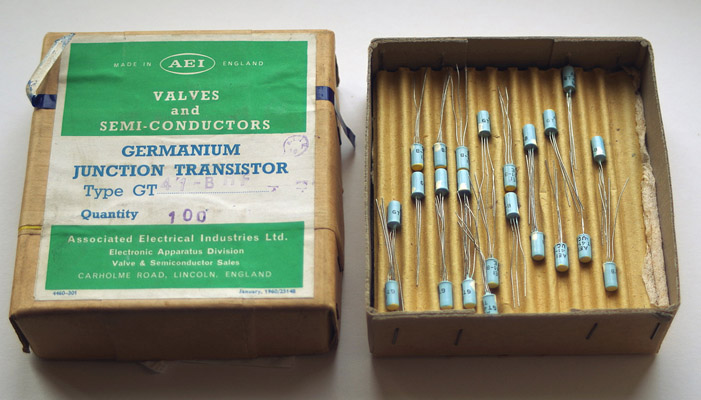
Just for fun, here's a box containing 98 AEI GT41-B transistors (it originally contained 100). I have a similar but unopened box of GT45-Bs.
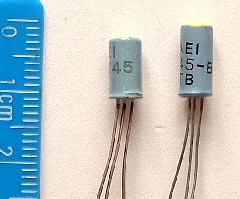
The types GT44 to GT47 have the same gain and frequently limits as GT40 to GT43, but with an increased maximum collector voltage of 25 volts (DC and peak). As my image of the GT45 shows, it is likely that all of these also came in the 'B' variant.
I am seeking examples of GT44-B and GT47. If you can help me obtain some, or can provide documentation on this larger form, please
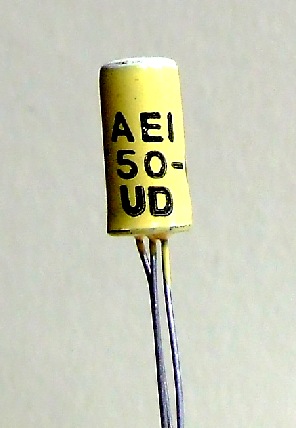
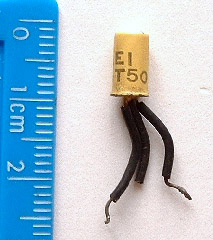
My extensive library of data books and sheets fails me when it comes to these devices, marked AEI GT50 and the larger GT50-B. Does the yellow colour indicate a different application from the above types, switching perhaps? If anyone has data on these transistors, please
The booklet 'AEI Semiconductor Devices' for 1961 lists a number of 2N-series transistors, which can be found to originate from General Electric in the USA, who originally had a financial interest in BTH. I do not know whether or not any of these were ever branded AEI, certainly I have never seen any.
If you know of any BTH- or AEI-branded 2N-series types, please
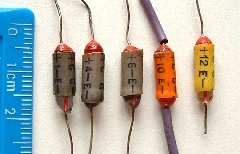
Returning to germanium diodes, BTH made more CG types in 'Form E': glass capsules that are irregular in shape and sometimes variable in length, suggesting some were hand made. The series is:
with a variety of colourful rubber or plastic sleeves. They are all general-purpose or detector diodes with various inverse voltage limits. They are described in the 1954 book 'Crystal Rectifiers and Transistors' and are listed as obsolete types in the 1961 Wireless World Radio Valve Data book.
I am seeking examples of CG1-E and CG3-E for my collection. Please if you know where I might obtain some.

There seems to have existed another 'form' of some of these CG diodes: form M. The members are:
These are listed in several 'Bernards' electronics publications, notably BP102,40 circuits using Germanium Diodes dated January 1961, and also in the 1966 Romanian (!) book 'Catalog de Dispozitive Semiconductoare' by Veronica Vatasescu and Serban Epure. I would be very interested to obtain any or even just see an image of one. If you can help, please
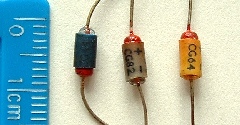
Lastly are 'Form H' miniature diodes, also in glass bodies with coloured sleeves, although the suffix is not printed on the devices. Three series are included in the booklet 'AEI Semiconductor Devices May 1960'. It is also possible to find some with painted glass bodies without a sleeve, presumably later production.
The CG40-H trio are point-contact switching diodes:
The CG50-H / CG60-H series are point-contact diodes for general-purpose use as detectors, modulators, frequency converters, pulse separators etc.
The CG80-H series are germanium gold-bonded diodes for computer and data processing applications.
Two more series are included in later AEI publications. I believe they are all switching diodes:

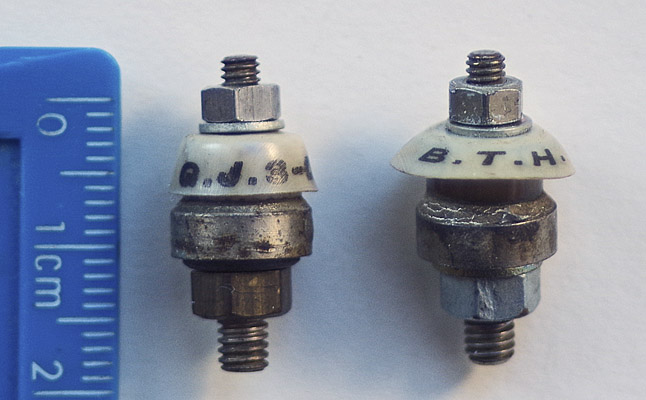
BTH first series of germanium junction rectifier diodes from about 1954 use a metal body with a glass/ceramic insulator around the anode and a threaded bolt at end. A plastic disc should be moulded around the insulator but one of my examples is splayed out. The series is a triplet GJ3-D to GJ5-D with each member having different maximum forward current and maximum reverse voltage. I am seeking examples of GJ4-D and GJ5-D.
This 'form D' outline seems to have been rapidly superseded:
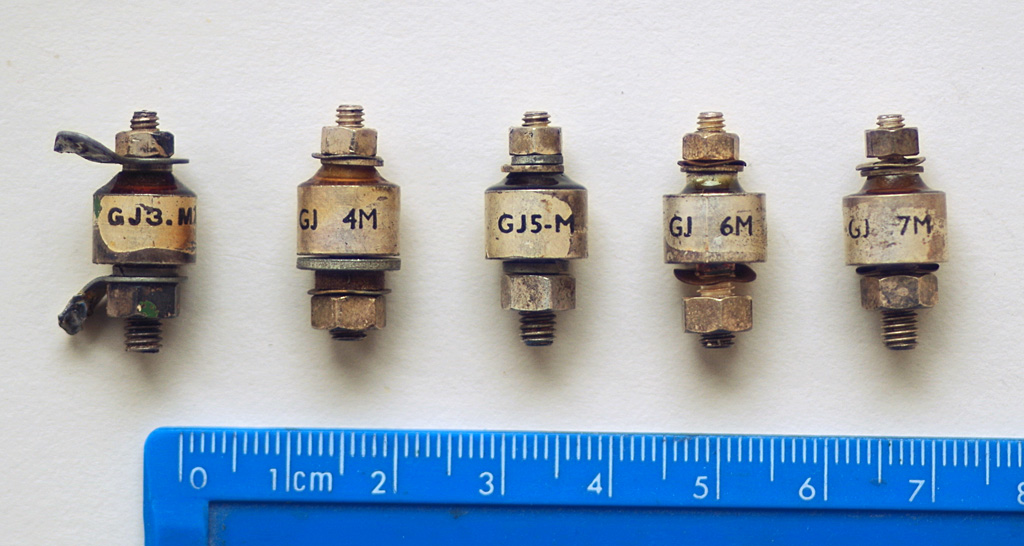
The GJ form M series of germanium junction rectifier diodes from about 1957 use a similar but longer metal body with a shorter glass insulator around the anode. The series comprises GJ3-M to GJ6-M with an apparently random selection of maximum reverse voltages, all with 1A maximum forward current, considerably more than the form D types. I also possess some examples of GJ7-M, which is not included in any of my data books but does appear on a data page from New Jersey Semiconductor.
If you can provide original data for GJ7-M, please
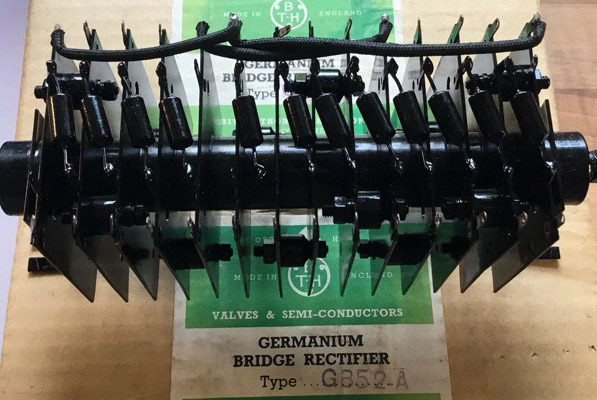
The 1960 'AEI Semiconductor Devices' lists two series of germanium diode bridges:
The only one I have come across is this quite large one, in a box printed 'BTH GERMANIUM BRIDGE RECTIFIER Type GB52-A'. As seems to be usual with such assemblies, it has been dipped in paint that sets to form an insulating coat. It contains a number of GJ-series diodes, but more than four so perhaps they are in series pairs. I'm informed that it is a voltage multiplier so the small cylindrical components must be capacitors. It is included in Wireless World 'Radio Valve Data' 1966 as a 480V 3A bridge.
The 1965 'AEI Abridged Catalogue' lists a triplet of germanium high-power rectifiers:
I have not come across any of these.
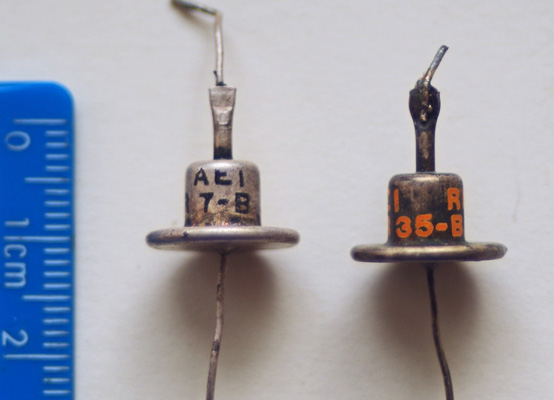
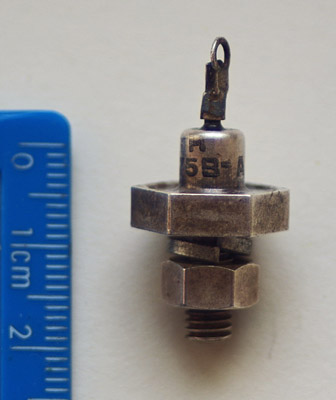
From about 1960, BTH (already owned by AEI, but both brandings can still be found on devices) were offering silicon junction diodes in series SJ and SL and silicon Zener diodes in series VR. Suffix letters were again used to indicate different outlines. The undated booklet 'Silicon Voltage Reference Diodes type VR' shows images of Form A, a tag-stud outline, and Form B, an idiosyncratic wire-ended outline with a large flange. Both outlines suffer readily from black tarnish, unusual on semiconductor casings and suggesting a possible silver content. The booklet contains data for the following, all exist with both suffixes:
My images show VR7-B, VR35-B and VR575B-A.
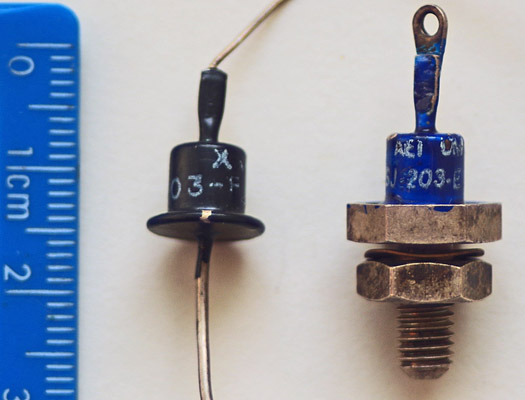
The booklet 'AEI Semiconductor Devices' from May 1960 lists the same VR types plus junction rectifier diodes:
Within about two years, Forms A and B were replaced by more standard painted outlines designated Forms E and F. My image shows SJ203-E and SJ203-F (on the left).
AEI soon started making Zener diodes in miniature all-glass outline:
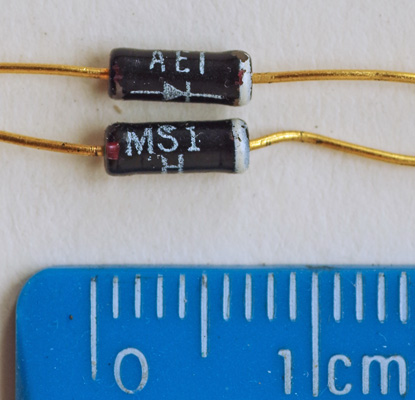
'AEI Semiconductor Devices May 1960' also includes silicon junction diodes in a miniature all-glass encapsulation:
The 1963 edition adds more:
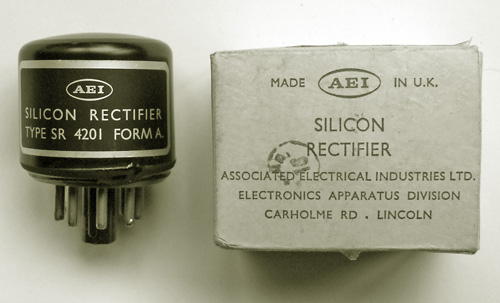
'AEI Semiconductor Devices May 1960' also lists a series of silicon junction diode units fitted on an octal base intended as a plug-in replacement for thermionic valve rectifiers:
The SR4201-A shown is the only one I possess, although I have some CV-series equivalents. These devices come with a stern warning about the risk of voltage surges at switch-on, as thermionic diodes have a much greater internal resistance than silicon ones.
For whatever reason, these do not seem to have become popular.
The booklet 'AEI Semiconductor Devices' for 1963 includes three short series of silicon EHT rectifiers:
I have not come across any of these. They comprise, I believe, multiple diodes potted into a longish plastic block with rounded ends and screw terminals.
There is also one rather oddly-named device:
The booklet 'AEI Semiconductor Devices' for 1961 lists a number of 1N-series diodes, which can be found to originate from General Electric in the USA, who originally had a financial interest in BTH. I do not know whether or not any of these were ever branded AEI, certainly I have never seen any.
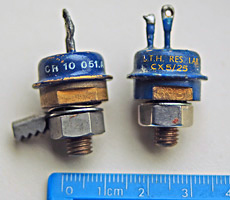
On the left in this image is an undated type CR10.051-A thyristor, or silicon-controlled-rectifier (SCR). The booklet 'AEI Semiconductor Devices' from May 1960 lists two series of these:
And the issue for April 1961 adds two more:
On the right is what I presume to be a prototype, marked 'B.T.H. RES. LAB. CX5/25'.
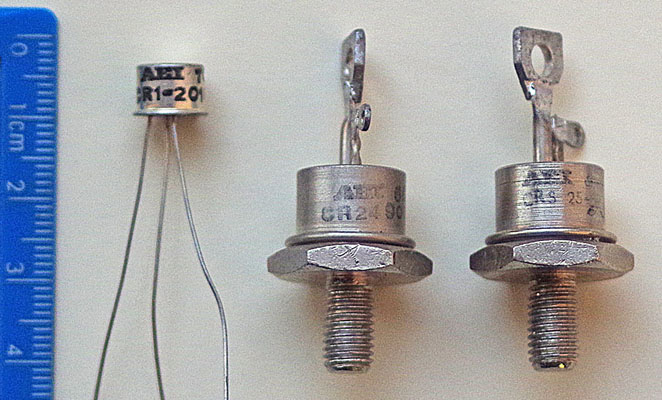
Here are three more modern-style SCRs, branded AEI. The TO-5 type on the left is a CR1-201C dated April 1970, the middle one is a CR24-903RB dated December 1968, and the rightmost is a CRS25-40 dated July 1968. This last is a puzzle because the CRS series is associated with STC, not AEI, so I am seeking data about this type. I am grateful to Ben Duncan Research (UK), Lincoln, for donating these devices to me.

The book AEI Semiconductor Devices dated April 1961 also lists more early BTH/AEI SCRs in a different series:
I am seeking vintage BTH/AEI thyristors apart from those shown above, particularly BTH-branded ones: if you can provide any, or data about the CRS series, please
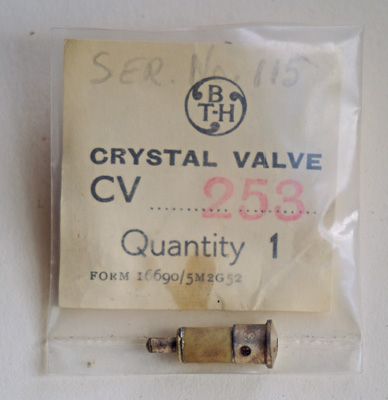
Like most UK semiconductor manufacturers, BTH and AEI made CV equivalents of their devices. These are military-grade versions of commercial types, given a Common Valve type designation. Many of the BTH/AEI types are microwave diodes, such as this quite early type CV253. I have never seen a CV-series BTH/AEI transistor, although the table below shows that several different types are listed in the 1963 CV Register and I'd love to acquire some.
I am interested in obtaining examples of the following CV types from the 1963 CV Register:
| CV164 = CG3-E | CV367 = CS2-A | CV478 = CG64-H | CV1844 = CS3-B | CV1907 = CS2-C | CV5370 = CG50-H |
| CV7042 (BTH/AEI version only) = GT41 | CV7329 = CR10.101-A | CV8582 = GT42 | CV8791 = CG91-H | CV9106 = GT46 | CV9111 = GT43 |
| CV9232 = CG80-H |
If you know where I can find any of these, please
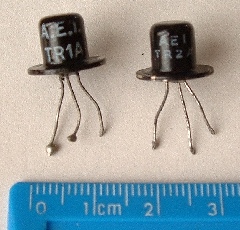
Here are two transistors in the black-painted 'top hat' encapsulation that is unique to early Ediswan devices, but marked AEI TR1A and TR2A. Ediswan fell under the AEI umbrella, but why did AEI brand these two transistor types as their own?
I am grateful to John Hills of Oregon in the USA who has explained that these TR1A and TR2A transistors were supplied to Tri-ang (Lines Bros) for use in their Tri-onic kit sets. These sets were probably only produced for a few years from 1961 until 1963. John's 1961 'A' set contains two top hat transistors marked 'A.E.I. TR1A' and 'A.E.I. TR2A', exactly like mine. These kits contained components in plastic housings with connecting pins that plugged into a series of circuit boards, Tri-ang designated the 'A' set transistors as TR4 and TR5. TR4 is the TR1A and is described as being the RF transistor, which John believes to be an Ediswan XA101 or XA102. TR5 is the TR2A and is described as being the AF transistor, which John thinks may be an Ediswan XB102, XB103 or possibly XB104. John has other Tri-onic kits and some have transistors marked 'A.E.I. TR1' and 'TR2' but in metal cans with plastic sleeves that are probably later Ediswan types. Even later kits contain Mullard OC series transistors. In 1962 Tri-ang introduced the kit 'A/B', This added five more printed circuits and other components including another RF transistor in the TO7 outline, probably a Mullard AF11n type.